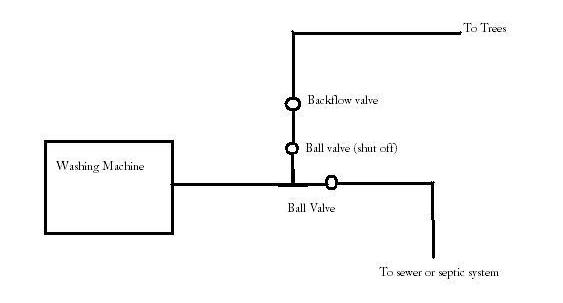|
How to Use Grey WaterGrey Water is the subject of much confusion and misinformation as it relates to Green Living. Is it one of the pieces of the Green Living package? Absolutely. Can it have a positive impact? Absolutely. Does it have a major impact? maybe not! But it sure does help in saving water! Grey Water is the waste water from washing. Washing clothes, washing dishes, or washing our bodies (showers and baths). Waste water from the toilet is not what we are talking about - it is called black water and is not to be reused! 
The use of grey water is heavily restricted or even banned in most localities, in my opinion this is based more on emotion than on science. It is estimated that more than 20 million Americans are reusing grey water in some fashion without any problems. Is it safe? By following a few common sense guidelines, the safe use of grey water should be easy to achieve. -If you are washing a load of soiled diapers - this water should not be reused. -Apply at or below the soil surface ? don't use a sprinkler system which will release small particles of waste water into the air. -Don't surface irrigate your lawn - again, we want to avoid direct contact with the recycled water. -Don't store grey water for more than 24 hours - it will soon turn into black water! -Don't use on the edible parts of vegetables - in other words don't use on carrots, radishes and potatoes. So where should you use your recycled water? The easiest and best use of grey water is to irrigate trees (shade or fruit). This can be a very simple gravity system from your washing machine, easy to install and use. The trees are generally quite forgiving if you do a bit more or a bit less laundry, and your laundry detergent won't bother them. Your top load washer uses about 30 to 40 gallons of water per load, while a front load uses much less, usually around 15 to 20 gallons per load. Depending on how much laundry you do, this can be a few hundred gallons per week, certainly enough to water a dozen or more trees. Keep your system simple. If your plans call for pumps and storage units, you will probably spend more on electricity than you will save in water. And you will probably have a net negative environmental impact! A gravity fed system is really quite simple. Find where the drain from your washer is and start here. Install a tee with a ball shut off valve to both the sewer or septic and to your outdoor water system. This will allow you to shut off your outdoor system if you are washing diapers, or the plants simply don't need any water that day. Also install an inline swing valve as a backflow preventer on the line that goes outside. This will prevent the recycled water from going back into your washer. This is gravity feed so don't try to run the pipe uphill! Run your PVC pipe (I like to use 2" from the washer to the irrigated area to make sure I don't put extra pressure on the washer, then reduce to 3/4") to your area to be watered. Use an adjustable bubbler type head at each tree, that will allow you to adjust the volume at each head so that you can even out the flow to each tree. That's really all there is to it! 
Recycling your washing machine water is an easy way to save water - a couple hundred gallons per week. If you live in an area with consistent severe droughts you may need a more complicated system where you capture your dishwashing and bathing water - but for the vast majority of us, a simple washing machine system works best.
After using grey water, how else can you save water?
|
